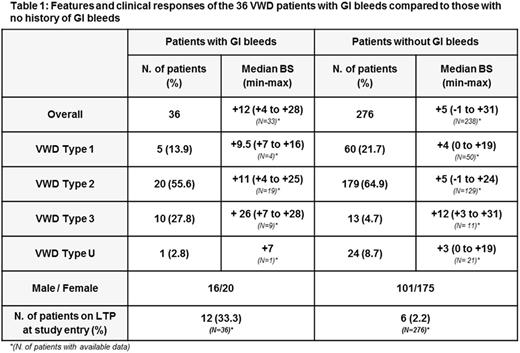Abstract
Von Willebrand Disease (VWD), the most common inherited bleeding disorder, is related to a von Willebrand factor (VWF) defect and/or functional abnormality. VWD is primarily characterized by mucocutaneous bleedings as a result of primary haemostasis defect, excessive haemorrhage after invasive procedures, and, less commonly, by soft tissue haematomas and joint bleedings.
Some patients with VWD may be subjected to recurrent overt or occult bleedings in the gastrointestinal (GI) tract associated with angiodysplasia which are challenging complications. Angiodysplasia occurs most commonly in middle-age or elderly patients in the cecum and ascending colon, but sometimes throughout the whole colon and stomach. These affected patients may need to be hospitalized for long periods of time and often require several weeks of therapy leading to high costs and poor quality of life. We report here the first results of GI bleedings impact on the Health-Related Quality of Life (HRQoL) of patients with VWD enrolled in the French WiSH-QoL study.
As both VWD and its treatment affect patients' and, possibly, their families' everyday life, the French non-interventional study, WISH-QoL aims to assess HRQoL in VWD patients of any age and to evaluate associated costs related to VWD management.
Clinical phenotype such as bleeding score (BS - Tosetto score), biological profile is documented. Patients are treated with the triple-secured plasma-derived VWF concentrate almost devoid of FVIII WILFACTIN. Patients fill in a booklet collecting information on socio-demographic and resources consumption. Clinical characteristics and therapeutic approach are recorded. HRQoL is assessed with the generic SF-36 (for adults) and the chronic-generic DISABKIDS Short Form (for children and adolescents) and the VWD-specific VWD-QoL (for adults, children and adolescents). In addition treatment satisfaction is evaluated. At least 350 patients will be followed during 2 years.
Since October 2014, 327 patients have been included.
At time of the current analysis, out of 312 patients with evaluable data, special attention is given to the specific clinical subgroup of 36 patients with recurrent bleeding from the gastrointestinal tract.
These patients exhibited an age distribution ranging from 3.3 to 83.0 year-old with a 44.5 y.o median. Among them, 3 children were less than 6 years but elderly were more represented with 10 adults more than 65 years. Females were more represented than males 20 (55.5%) vs. 16 (45.5%), respectively.
Among them, 5 had type 1 VWD (type 1Vincenza: 3; type 1: 2), 20 had type 2 (2A: 11; 2B: 6; 2M: 1 and 2 unspecified: 2), 10 had type 3 and 1 with a type undetermined (Table1).
The median Tosetto bleeding score (BS) reported for 33 patients with GI bleeds was higher +12 ranging from +4 to +28 compared to +5 (-1 to +31) in patients without history of GI bleeds as described in Table1. It was also able to distinguish disease severity by VWD type; Type 3 VWD had the highest bleeding scores.
At time of inclusion, 24 of these 36 patients were On-Demand treatment and 12 patients (4.7 - 70.4 years of age) were and are still requiring Long-Term secondary Prophylaxis (LTP) with this VWF because of joint and or gastro-intestinal bleeds. For 12 out of these 36 patients, the endoscopic procedure Argon plasma coagulation (APC) was used. For 5 of these patients, the procedure was associated with a secondary LTP and they were on regular prophylaxis with VWF concentrate at WiSH-QoL study entry.
As frequently in VWD management, patients may need to stay on long-term iron therapy. This concomitant treatment has been recorded in 15 (45%) patients' file. Ten (28%) patients have also received anti-ulcer drugs.
Thus, this study will provide an important contribution to knowledge in VWD patients with GI episodes that is challenging due to the severity and recurrence of bleeds. These findings may teach us what would be the best treatment such as LTP. With the HRQoL results especially the VWD-specific evaluation of HRQoL and treatment satisfaction, a deeper insight into these patients' real daily life and their specific health care needs will be gathered as well.
Borel-Derlon: LFB: Honoraria. Chatelanaz: LFB: Employment. Doriat-Robin: LFB: Employment. Goudemand: LFB: Honoraria. Von Mackensen: LFB: Honoraria.
Author notes
Asterisk with author names denotes non-ASH members.


